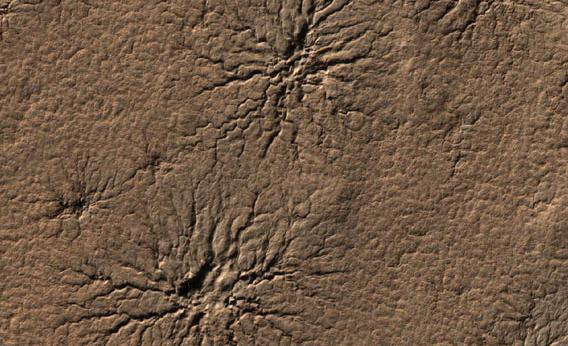Create a free profile to get unlimited access to exclusive videos, sweepstakes, and more!
Attack of the Martian Tree Spiders!

Years ago, in 1999, some odd pictures were returned from The Mars Global Surveyor space probe orbiting the red planet. They showed what looked for all the world(s) like trees, banyan trees, dotting the Martian landscape. They made quite a splash on the internet, and you can see why; hereâs a section of one of the pictures:
No fooling, they really do look like trees. The usual pseudoscience website went nutsâwell, more nutsâclaiming they were life on Mars. More rational heads knew they were formed from some sort of natural non-biological process, but what?
Over time, more and better pictures were taken, and eventually the story became clear. Hints were found when these features were detected at extreme latitudes, and only in the spring. That meant they must be related to the change in seasons, specifically to the weather warming. That, plus some high-resolution images, made it possible to eventually figure out what they are.
Mars has a thin atmosphere thatâs mostly carbon dioxide. In the winter at the poles it gets cold enough that this CO2 freezes out, becoming frost or snow on the Martian surfaceâwhat we on Earth call dry ice. It gets this name because when you warm it up, it doesnât melt: It turns directly from a solid into a gas, a process called sublimation.
In the Martian spring sunlight warms the ground, which warms the layers of dry ice. They sublimate slowly, andâhereâs the cool partâfrom the bottom up. Dry ice is very white and reflective, so sunlight doesnât warm it efficiently. The ground is darker, and absorbs the solar warmth. This tends to heat the pile of dry ice from the sides and underneath at the edges.
The newly released gaseous carbon dioxide needs somewhere to go. It might just leak away from the side, but some will find its way deeper into the dry ice pack, toward the center. If the gas finds a weak spot in the ice itâll burst through, creating a hole. Other trickles of CO2 under the ice will flow that way as well, and eventually find that hole. What you get, then, is dry ice on the surface laden with cracks, converging on a single spot where the gas can then leak out into the Martian atmosphere like dry geysers. The plumes of CO2 will carry with them dust from the ground under the dry ice pack, depositing the darker dust on the brighter surface ice, discoloring it.
And when you look at them from above, you see what look like trees! After a while, the carbon dioxide frost sublimates away entirely, and all youâre left with are weird looking spidery channels in the ground, up to a couple of meters deep, created by erosion as the carbon dioxide gas wended its way under the dry ice pack. These are even called araneiform features, meaning spider-like. They also kinda look like the cell bodies of neurons. Unsettling. But probably a better situation than an infestation of giant alien tree spiders.
How cool is that? While reading about this, I found various other features that have a similar origin, created from carbon dioxide gas flow. One aspect really got to me, a simple but terrifically strange observation: In some of these features on Mars, the tracks get wider as they go uphill. Thatâs the opposite of what youâd expect from the flow of an actual liquid; channels created by, say, water on Earth get wider as they flow downhill. This means whatever formed those channels must be flowing uphill. So the culprit must be gas, not liquid.
That is so flippinâ weird! Itâs bizarre enough that a major component of a planetâs air might freeze out at all, but then to have some it flow uphill in the spring, and also to create those creepy spidery things?
Mars is a damn odd place.Â


























